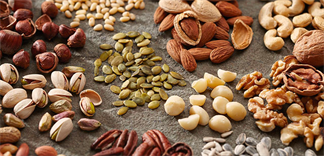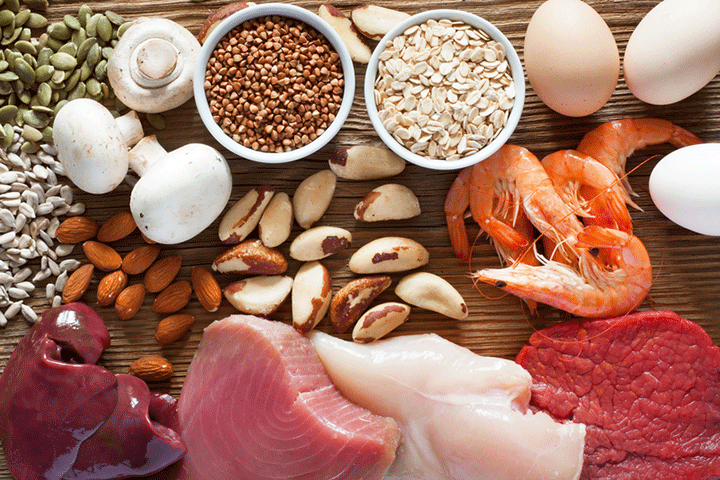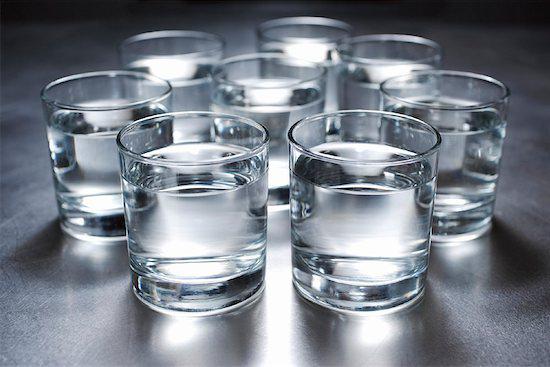Though everyone has their go-to facial treatment, glowing skin really does begin from the inside out. In order to maintain the continual shedding and replacement of older skin cells, a steady supply of nutrients is required. With the right diet, you can nourish your skin and help it stay smooth, supple, and spotless.
Age spots and wrinkles are a natural part of aging, but sun exposure, tanning beds, harsh soaps, chemicals, and a poor diet can speed up the process. The solution is to hone your skincare routine, adjust your lifestyle, and optimize your nutrition by eating a wide variety of colorful fruits and vegetables high in antioxidants, oily salmon, almonds, and water.
1. Eat at least five servings of fruit and veggies daily

Antioxidants found in fruits and vegetables are so strong that they can neutralize free radicals before they cause damage to skin cells. Smoking, pollution, and UV rays are all potential sources that can set off these free radicals.
Try to obtain at least five servings of fruits and vegetables every day, and eat a wide variety of colors. Lutein, found in dark greens like kale, papaya, and spinach, and beta-carotene, found in orange fruits and vegetables like carrots, sweet potatoes, and pumpkins, are essential for regular skin cell formation and a healthy skin tone.
2. Eat some vitamin C

Vitamin C is essential for healthy immune function, radiant skin, and the speedy healing of scars. Blackcurrants, blueberries, broccoli, guava, kiwis, oranges, papayas, strawberries, and sweet potatoes are excellent food sources.
In addition to fortifying the capillaries that carry the blood that nourishes our skin, vitamin C is essential in the production of collagen, the protein that forms the scaffolding that maintains our skin full and maintained.
3. Eat a zinc rich diet

Zinc helps to maintain skin supple by supporting the regular functioning of the skin’s oil-producing glands. It also aids in the healing process and the repair of skin damage. Fish, lean red meat, whole grains, poultry, nuts, seeds, and shellfish are all high in zinc.
4. Eat vitamin E

Vitamin E is essential for skin protection against oxidative (cell) damage and photoaging. Almonds, avocados, hazelnuts, pine nuts, and sunflower and pumpkin seed oil are all high in vitamin E.
5. Get some selenium

Selenium, along with vitamins C and E, is a potent antioxidant. Preventing skin cancer, sun damage, and age spots may be easier with a selenium-rich diet, according to research. Consuming Brazil nuts is one method to increase your consumption. The daily value can be met with just two or three nuts. As a healthy snack or topping for your salad, combine Brazil nuts with other seed varieties high in vitamin E. Fish, shellfish, eggs, wheat germ, tomatoes, and broccoli are also excellent food sources.
6. Add some good fats

Certain fats function as a natural moisturizer for your skin, keeping it smooth and boosting suppleness. Monounsaturated and polyunsaturated fats can be found in avocados, fatty seafood, nuts, and seeds. These fats have been expertly packed with a healthy dosage of vitamin E.
Pay careful attention to food sources of omega-3 fatty acids, a type of polyunsaturated fat. These fatty acids have anti-inflammatory properties and may aid in the treatment of skin disorders such as eczema and psoriasis. They are also the foundation of good skin.
Omega-3 fatty acids can be found in oily fish such as salmon, trout, and sardines, as well as plant sources such as flaxseed, chia seeds, walnuts, and rapeseed oil.
7. Pick low-GI carbohydrates

The glycaemic index (GI) is a way to rank foods based on how quickly or slowly they break down into glucose in the body. Try to eat a lot of beans, lentils, cereal, and other foods that are low in glycemic index and slow to release sugar. These carbs slowly release their energy into the bloodstream. This gives you a steady source of energy and makes you feel full, so you’re less likely to want to snack.
Avoid high-GI carbs like cookies and sugary drinks because they make your body make insulin, which can damage collagen and speed up the aging process.
8. Eat more plant-based estrogens

Plants contain natural substances called phyto-estrogens. They are believed to assist in maintaining the balance of our natural hormones since they resemble the female sex hormone oestrogen in structure. This is significant because oestrogen supports skin structure and reduces skin damage, which are both crucial for skin health.
Different kinds of plant ‘oestrogen’ exist; some are found in soy products like tofu and tempeh, while others are found in the fiber of wholegrain foods, fruit, vegetables, and flaxseed.
9. Six to eight glasses of water a day is recommended

Water is essential for the pliability of skin. Skin can become dry, dull, and even gray from even minor dehydration. Drinking six to eight glasses of water daily is recommended by health professionals. Water is ideal, but any fluid will count toward your daily allotment.
